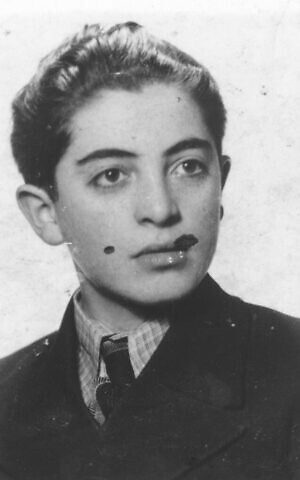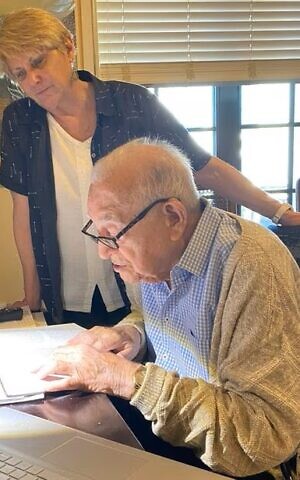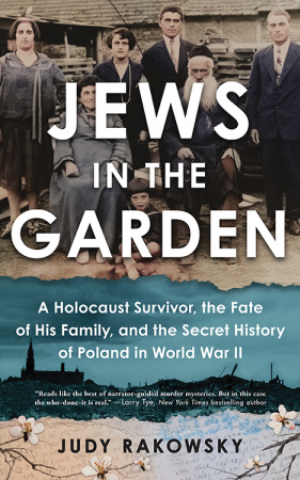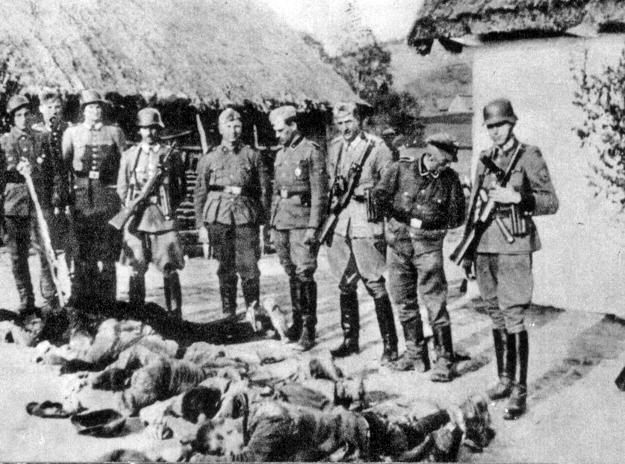When investigative journalist Judy Rakowski discovers the mass grave of five relatives killed in the massacre, she and her cousin decide not to mark the spot for fear of attracting vandals, grave-robbers and angry townspeople. Instead, he wrote a book about them – and their possible killers.
Published July 11,”Jews in the Garden: A Genocide Survivor, Her Family’s Fate, and the Secret History of Poland in World War II,” follows Rakowski’s investigation into two groups of relatives killed under mysterious circumstances near the end of World War II.
At a farm outside Kraków, five of Rakowski’s relatives were murdered after hiding for 18 months. One of them – 16-year-old Hanna Rozenek – survived the massacre, and Rokowski became determined to learn her fate.
As an eyewitness told Rakowski about his relatives who were hiding at the ranch, “[The family] Buried next to a large cherry tree. Every year, the tree bore fruit, but the cherry soon turned black. Everyone was afraid to eat them, thinking that the Jews buried below must have poisoned or cursed them. Then the tree died.
Collecting dozens of clues over three decades of research, Rakowski partnered with his cousin – 98-year-old Holocaust survivor Sam Rakowski Ron – on nine research trips to Poland.
During their early visits to Poland, Rakowski and his cousin gained access to archival materials. He said, however, that the situation has worsened in recent years.
“I had challenges getting records in this country. the change that followed [Law and Justice] The workload of the party was noticeable. It got tough,” said Rakowski, a longtime reporter and editor for publications including People Magazine and The Boston Globe.
At the beginning of “Jews in the Garden”, Rakowski reveals that Polish partisans – members of the Home Army underground resistance movement – were responsible for the murder of his relatives. In one place, partisans forced Jews to jump out of a second-floor window and shot them dead.
After the war, some individual Home Army members received recognition from Yad Vashem for helping to rescue Jews. However, there are far more documented accounts of Polish “partisans” tracking down Jews in hiding and murdering them, whether for their valuables, their property, or for anti-Semitic reasons.
“I wanted to be very faithful to the facts of the Home Army [in the book],'” Rakowski told The Times of Israel. “The Home Army did not have control over every sub-group. Changes happened where they had control and where they didn’t,” he said.
From the original book,night without end: The Fate of the Jews in German-occupied Poland,” Rakowski learned of the Partisan massacres of Jews throughout the Kraków region, including his cousin’s hometown, Kazimierz Wielka.
Rakowski said of the book, “It’s very serious.” “The studies in the county my family comes from have not been translated into English. It’s chilling,” Rakowski said.
during the so-called Judenjagd (Jewish hunting) Phase of the Holocaust in Poland, Jews who escaped deportation to Germany’s three “Operation Reinhardt” death camps are captured by the Germans in collaboration with the Polish authorities and – extremely important – the Poles who cheated about the location of Jewish hiding places.
In recent years, the government of Poland has put pressure allegations against historians who publishes “outrageous” research on the activities of Poles during the Holocaust.
Rakowski said, “Governments have gotten into the game of historical narrative.” “Ultimately, it’s sad because the achievements of partisans should be celebrated,” said Rakowski, who plans to visit Poland with her cousin in September.

The Home Army, the unit of Poland’s underground resistance against the German occupation. (public domain)
Rakowski said, “We can’t just have history as a Hollywood story, or else we’ll never move beyond what happened.” “Many Poles want to celebrate and learn about the history of the Jews who lived there. And it gets in the way.”
‘They just wanted to live’
During his fact-finding mission in Poland, Rakowski relied heavily on his Holocaust survivor cousin to translate conversations into English. At one point, Sam tells Rakowski that she was a “burden” and was not needed on the next trip.
“When he pushed me aside a little bit, I became more engaged,” said Rakowski, who ultimately earned her cousin praise for exposing more than she thought was possible.
during the war, Sam Rakowski To avoid being caught outside the city, he hid himself in the Kraków Ghetto. He was imprisoned in several forced labor camps and in 1944 survived a death march from Sachsenhausen concentration camp outside Berlin.
Every time Rakowski and her cousin visited Poland, they came back to America with a few more pieces of the puzzle.
In personal meetings with Sam in Poland, Rakowski said, her cousin warmed to her, persuading people to open drawers in the archives and uncover painful memories.
“We’ve reached out to relatives of those who tried to save our family,” Rakowski said.
One of the subplots of the book is the relationship between Rakowski and Danuta Sodo Ogorek, whose grandparents hid Rakowski’s relatives on their farm.
Rakowski wrote of finding the mass grave at Sodo Farm, “It was shocking enough to find a family of five buried in a working farmyard, let alone discover that they were Sam’s aunt and uncle and three older cousins.”
Amazingly, the Sodo family is still stigmatized for attempting to save Jews, as Rakowski explained.
Rakowski wrote, “The community had shunned her family, not only punishing her grandparents for trying to save five lives, but holding a grudge against them for three generations.” “He cleared it up. “It tells more about him than his family,” he said.

Eventually, a major breakthrough came when a former Peasant Battalion leader told Sam Rakowski that members of his group murdered the Rosnecks. (Judy Rakowski)
Rakowski wrote, Sodo is guided by his family’s strong Catholic faith. But during the German occupation of the village, the neighbors grew increasingly resentful of the Sodo family for hiding Jews, leading neighbors to say that the entire village faced German retribution.
“These Jews, your family, they just wanted to live,” Sodo told Rakowski.
Not long after the war ended, Sodo and her husband built a new home on their family farm. When choosing a place, he took into account the location of the mass grave where Rakovsky’s relatives were buried.
During one of Rakowski’s recent visits to Poland, he and Sodo talked about why Rakowski keeps returning to the country. For Sodo, there was no mystery in the question.
“Your people are here,” Sodo told Rakowski, which triggered something within the investigative journalist.
Rakowski wrote, “I tremble.” “I was no longer a tagalong or a spectator. These lands, these stories, were now a part of me.”



